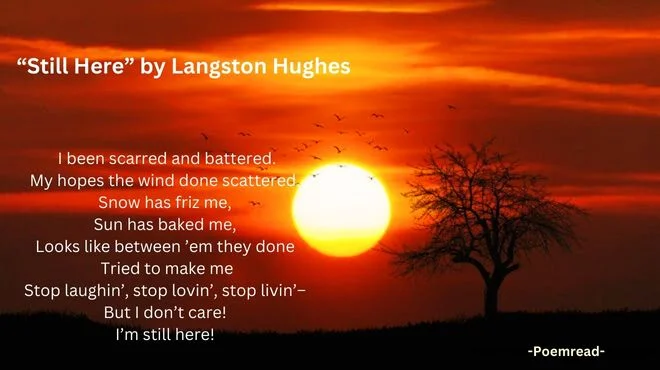
Langston Hughes’ poem “Still Here” is a powerful piece of literature that explores the themes of perseverance and resilience in the face of adversity. In this blog post, we will delve into the various aspects of the poem, including its subject, the author’s background, the context in which it was written, the theme and tone, and the form or structure of the poem.
“Still Here” by Langston Hughes I been scarred and battered. My hopes the wind done scattered. Snow has friz me, Sun has baked me, Looks like between ’em they done Tried to make me Stop laughin’, stop lovin’, stop livin’– But I don’t care! I’m still here!
Content
- Subject of Langston Hughes' 'Still Here'
- About the Author: Langston Hughes
- Context of Langston Hughes' 'Still Here'
- Theme and Tone of Langston Hughes' 'Still Here'
- The Form and Structure of Langston Hughes' 'Still Here'
- Line-by-line Analysis
- Analyzing Poetic Devices in Langston Hughes' 'Still Here'
- Interactive Summary of Langston Hughes' 'Still Here'
Subject of Langston Hughes’ ‘Still Here’
In Langston Hughes’ poem “Still Here,” the theme of resilience in the face of challenges is prominent. The speaker reflects on enduring difficult circumstances but remains determined to persevere. Through straightforward language and a defiant tone, Hughes conveys the message that, despite adversity, the human spirit can prevail. The poem celebrates the strength and resilience inherent in individuals who refuse to be defeated by life’s obstacles.
About the Author: Langston Hughes
Langston Hughes (1901–1967) was an American poet, social activist, novelist, playwright, and columnist from Joplin, Missouri. Hughes, one of the earliest innovators of the literary art form called jazz poetry, is best known as a leader of the Harlem Renaissance, a cultural movement that celebrated African American art and literature in the 1920s and 1930s.
His works often reflected the experiences of African Americans and explored themes of identity, discrimination, and social injustice. Hughes’ writing style was characterized by its simplicity, directness, and use of vernacular language. He famously wrote about the time when “the Negro was in vogue,” which was later changed to “when Harlem was in vogue.”
Growing up in a series of Midwestern towns, Hughes became a prolific writer at an early age. He moved to New York City as a young man, where he made his career. He graduated from high school in Cleveland, Ohio, and soon began studies at Columbia University in New York City. Although he dropped out, he gained notice from New York publishers, first in The Crisis magazine and then from book publishers, and became known in the creative community in Harlem.
He eventually graduated from Lincoln University. In addition to poetry, Hughes wrote plays and short stories. He also published several nonfiction works. From 1942 to 1962, as the civil rights movement gained traction, he wrote an in-depth weekly column in a leading black newspaper, The Chicago Defender.
Context of Langston Hughes’ ‘Still Here’
“Still Here” by Langston Hughes was written during a period called the Harlem Renaissance. This was a time in the 1920s and 1930s when many African American artists and thinkers came together in Harlem, New York, to celebrate their culture and fight against discrimination. Langston Hughes was a well-known poet during this time and often wrote about the struggles and triumphs of African Americans.
In “Still Here,” Hughes’ speaker talks about facing tough times but refusing to give up. The poem reflects the challenges that many African Americans faced, such as racism and poverty. Despite these difficulties, the speaker in the poem shows resilience and strength. “Still Here” is a powerful reminder of the courage and determination of African American communities during a time of struggle.
Theme and Tone of Langston Hughes’ ‘Still Here’

The theme of “Still Here” is resilience and hope. The poet shows his courage and optimism in facing the challenges that life throws at him, such as being “scarred and battered” by the wind and the sun, but still laughing, loving, and living. The speaker does not give up on his dreams or his identity but rather embraces them with pride and joy.
He declares that he is “still here”, despite the hardships and oppression that he has endured. He also implies that he is not alone but part of a larger community of people who share his struggles and his aspirations. The theme of resilience and hope is relevant and inspiring for anyone who faces difficulties or discrimination in their lives and who wants to overcome them with dignity and grace.
The tone of the poem is defiant and confident. The poet does not let his circumstances discourage him but rather uses them as motivation to keep moving forward. He uses strong and assertive language, such as “I’m still here”, to express his self-worth and his determination.
Furthermore, he uses repetition and rhyme to create a sense of rhythm and harmony, which contrasts with the harsh and chaotic reality that he describes. He challenges the forces that try to break him down and affirms his identity and his humanity. The tone of the poem is powerful and uplifting, as it conveys the poet’s spirit of resistance and his vision of a better future.
The Form and Structure of Langston Hughes’ ‘Still Here’
Form and Structure
The poem consists of seven lines, each short and concise, contributing to its straightforward delivery. This brevity reflects the speaker’s resolute and defiant attitude toward life’s challenges. Additionally, the poem’s conversational tone, characterized by colloquial language and vernacular expressions, fosters a direct connection between the speaker and the reader.
Rhyme Scheme
Langston Hughes’ poem “Still Here” follows an AABBCCD rhyme scheme, with end rhymes providing cohesion and musicality to the verses. This structured rhyme scheme adds a sense of rhythm and flow to the poem, enhancing its overall impact.
Repetition and Emphasis
The structure of “Still Here” incorporates repetition, with the phrase “stop laughin’, stop lovin’, stop livin’-” repeated to emphasize the speaker’s unwavering commitment to maintaining joy, love, and vitality despite adversity. This repetition serves to underscore the poem’s central theme of perseverance and resilience, driving home the speaker’s refusal to be defeated by life’s hardships.
Thematic Significance
In conclusion, the form, structure, and rhyme scheme of “Still Here” work in harmony to amplify its thematic significance. Through its concise lines, rhythmic rhyme scheme, conversational tone, and strategic repetition, the poem effectively conveys the speaker’s defiant resilience in the face of adversity, leaving a lasting impact on the reader.
Line-by-line Analysis
“been scarred and battered”
The opening line sets the tone for the poem, emphasizing the physical and emotional toll that life’s difficulties have taken on the speaker. The use of “scarred and battered” employs metaphor to convey the idea of enduring wounds and damage, suggesting a history of struggle and pain. Furthermore, the poet uses incorrect grammar (“I been” instead of “I have been”) to show his disregard for the rules of the dominant culture.
“My hopes the wind done scattered”
Here, Hughes employs personification by attributing human qualities to the wind, described as scattering the speaker’s hopes. The poet uses a metaphor to compare his hopes to the seeds or leaves that the wind has blown away. He also uses the word “done” to emphasize the finality and severity of his loss. He implies that forces beyond his control have destroyed or scattered his hopes.
“Snow has friz me, Sun has baked me”
The poet uses another incorrect word (“friz” instead of “frozen”) to continue his unconventional use of language. He also uses the image of snow to symbolize the coldness and isolation that he has experienced in a hostile society. He makes the implication that the extreme circumstances he has experienced have frozen or numbed him.
Then, the poet uses a contrast between snow and sun to show the extremes of his suffering. He also uses the image of sun to symbolize the heat and the exposure that he has endured in a cruel society. He implies that the intense pressure he has experienced has baked or burned him.
“Looks like between ’em they done”

This line employs colloquial language to convey the speaker’s defiance in the face of adversity. The use of “looks like” and “done” adds a sense of informality and immediacy to the speaker’s voice.
Additionally, the poet uses the word “between” to indicate that he has been caught in the middle of two opposing forces: the snow and the sun, or the white and the black, or the north and the south.
He also uses the word “they” to refer to the people or institutions that have caused him harm. In addition to that, he uses the word “done” again to stress the completion and magnitude of their actions.
“Tried to make me”
The poet uses the word “tried” to show that he has resisted or survived the attempts to make him do something against his will. He also creates suspense by breaking the sentence at this point and leaving the reader wondering what they have tried to make him do.
“Stop laughin’, stop lovin’, stop livin’–”
The poet uses a series of verbs that end with “-in’” to show his informal and colloquial style of speech. He also uses a parallel structure to list the three things that they have tried to make him stop: laughing, loving, and living. Furthermore, the speaker suggests that these are the essential aspects of his humanity and his happiness that they have tried to take away from him. He also uses a dash to indicate a pause or a change in tone.
“But I don’t care!”
This line serves as a defiant declaration of the speaker’s resilience and refusal to be defeated by life’s challenges. The use of exclamation and the emphatic “I don’t care!” convey the speaker’s unwavering determination to persevere despite the odds. He also uses a negative statement to express his indifference and his rejection of their attempts.
Moreover, the exclamation mark shows his defiance and confidence. He declares that he does not care about what they have done or what they think of him. Thus, he asserts his independence and his dignity.
“I’m still here!”
The poem concludes with a triumphant declaration of the speaker’s enduring presence and strength. This line serves as a powerful assertion of resilience and survival in the face of adversity.
Analyzing Poetic Devices in Langston Hughes’ ‘Still Here’
- Metaphor:
- Example: “been scarred and battered” – metaphorically describes the speaker’s past struggles and challenges as physical wounds.
- Personification:
- Example: “My hopes the wind done scattered” – personifies the wind, attributing human qualities to it by suggesting that it has scattered the speaker’s hopes.
- Imagery:
- Example: “Snow has friz me, Sun has baked me” – vivid imagery depicting extreme weather conditions as metaphors for life’s challenges.
- Repetition:
- Example: “Stop laughin’, stop lovin’, stop livin’-” – repeated phrase emphasizes the speaker’s determination to hold onto essential aspects of life despite adversity.
- Colloquial Language:
- Example: “Looks like between ’em they done Tried to make me” – informal language adds authenticity to the speaker’s voice, conveying defiance in the face of external pressures.
- Emphasis:
- Example: “But I don’t care!” – emphasizes the speaker’s defiance and refusal to be defeated by life’s challenges.
- Rhyme Scheme:
- Example: The poem follows an AABBCCD rhyme scheme, with end rhymes providing cohesion and musicality to the verses.
- Consonance:
- Example: “scarred and battered” – repetition of the consonant sound “d” adds a rhythmic quality to the line, enhancing its impact.
- Alliteration:
- Example: “Snow has friz me” – repetition of the consonant sound “s” emphasizes the harshness of the weather conditions described.
- Assonance:
- Example: “Sun has baked me” – repetition of the vowel sound “a” creates a sense of unity and continuity within the line.
Interactive Summary of Langston Hughes’ ‘Still Here’
In Langston Hughes’ poem “Still Here,” the emotions conveyed are those of defiance, hope, and strength. The tone conveys the narrator’s unwavering determination to overcome adversity. The poet’s intention is to celebrate the resilience of marginalized communities and inspire others facing similar challenges.
The poem is targeted at individuals who have experienced discrimination and hardships, offering them a sense of empowerment and solidarity. Thus, reading the poem evokes a feeling of admiration for the speaker’s ability to persevere in the face of adversity.
In conclusion, Langston Hughes’ poem “Still Here” is a testament to the resilient spirit of people who do not allow their circumstances to defeat them. Through its powerful imagery, emotional tone, and resilient message, the poem resonates with readers, inspiring them to find strength in the face of adversity.
RELATED POSTS
View all



